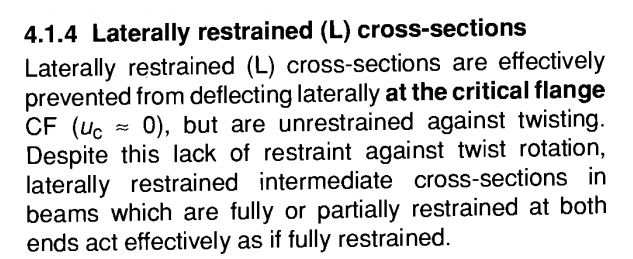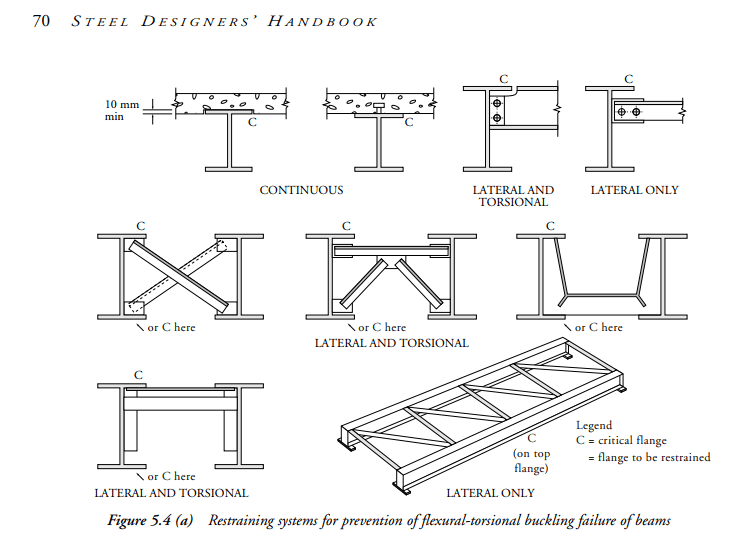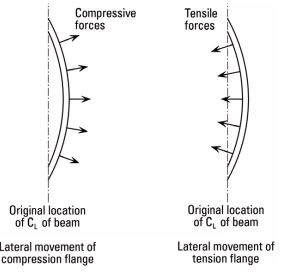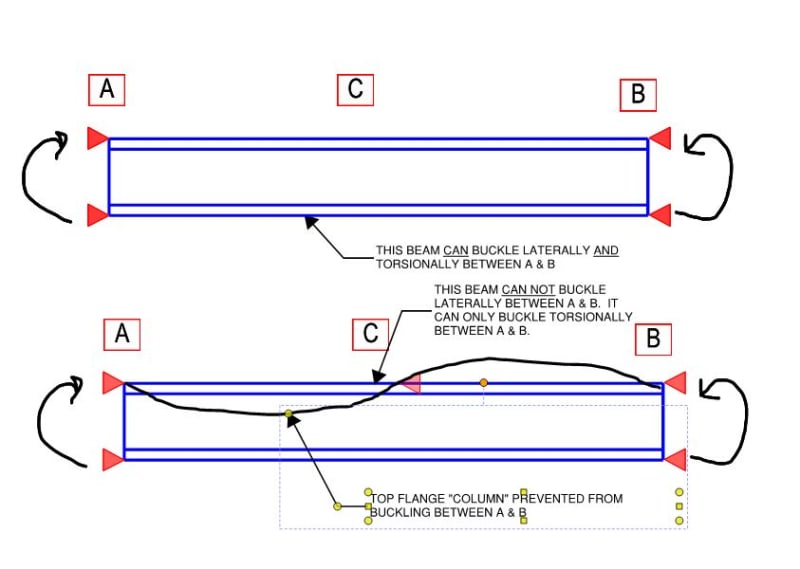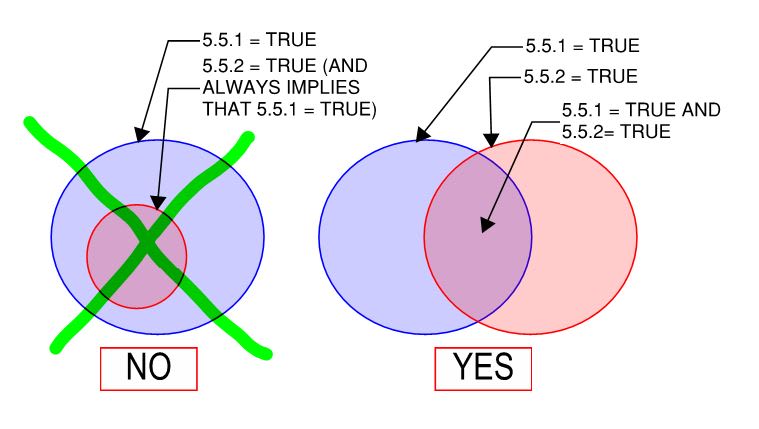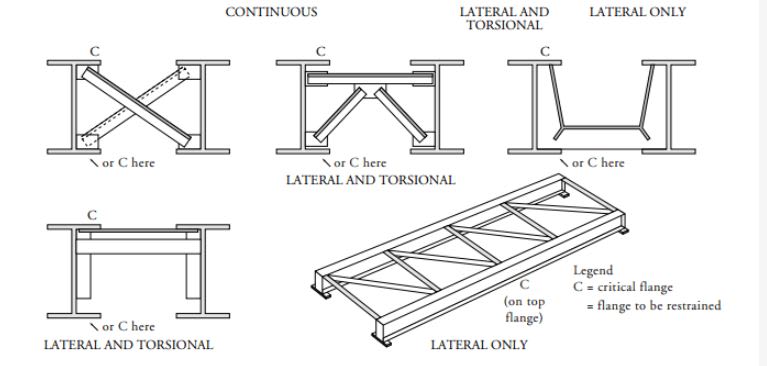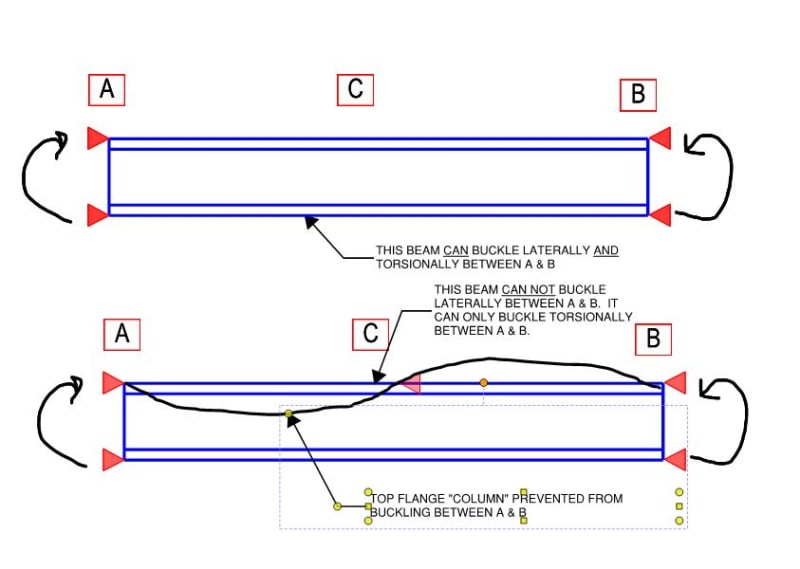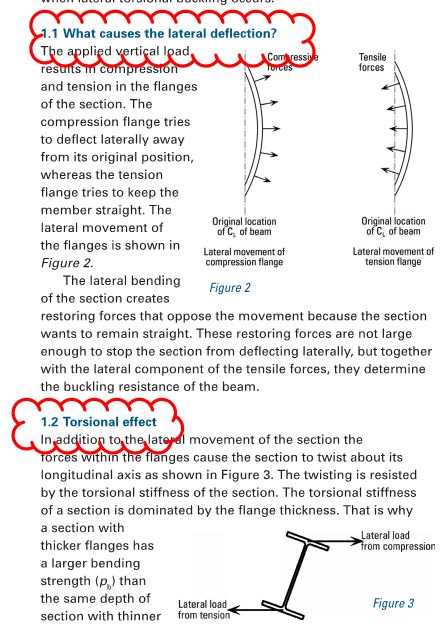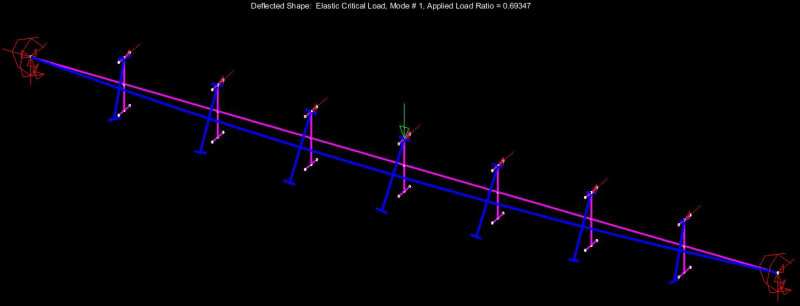[highlight #FCE94F]
KOOTK'S ALL ENCOMPASSING THEORY OF AS4100 LTB[/highlight]
For the sake of readability, I'm going to present everything that follows as fact even though it is really just my opinion. Just imagine all statements preceded by an "in my opinion".
When Steveh49 provided me with the revelation that AS4100 is treating L-restraints as Faux-F-Restraints, that gave me the missing puzzle piece that I needed really pull together a cohesive theory that I've been ruminating on for a few weeks.
A) WHAT THE THEORY WILL EXPLAIN
A1) Why we see the apparent discrepancy between the "compression flange" and "flange that moves furthest" definitions of the critical flange.
A2) Why, in the context of the AS4100 LTB method, a brace point
must restrain lateral translation and cannot simply restrain rotation (roll beam concept considered valid in AISC methodology).
A3) Why, in the context of the AS4100 LTB method, the tension flange
must not be treated as though it provides effective LTB bracing even if, in many real world situations, it may indeed provide effective LTB bracing.
B) WHY MY ANTIPODEAN FRENEMIES SHOULD LOVE THIS THEORY
B1) The theory explains all of the stuff listed above as a coherent, inter-related story. The truth tends to do this.
B2) The theory results in pretty much the most literal read of AS4100 possible. I know that it gets your guys' blood up when I try to reinterpret your codes. I would only alter 5.5.2 like this to avoid the confusion that we've seen in this thread:
AS4100 Modified said:
5.5.2 Segments with both ends restrained. The critical flange at any section of a segment restrained at both ends shall be the compression flange regardless of whether or not the compression flange would deflect the farther during buckling in the absence of restraint.
C) BACKGROUND
I've been debating LTB with folks on Eng-Tips for years now. And I always describe the phenomenon using the pedantic phrase
twist about a point in space located at, directly above, or directly below she shear center. I describe it like that because I feel that's the most precise description and the only one that keeps you out of trouble at free cantilevers and the like.
Invariably, somebody chimes in with "I disagree, LTB is really caused by the compression flange acting like a column and trying to buckle laterally while the tension flange attempts to straighten itself out". This is the argument shown below. I defend my position vigorously but, really, I sympathize. Most of the time, I think that compression flange buckling
really is the bulk of the LTB story and that LTB can pretty accurately be envisioned as the superposition of two separate effects:
C1) The [L] in LTB. A nearly pure lateral sway about a point of rotation in space above or below the shear center.
C2) The [T] in LTB. A nearly pure torsional roll over about the shear center or a point close to it.
Different situations have different proportions of [L] relative to [T]. For a free cantilever, for example, the center or rotation is somewhere down in the earth's mantle and [L] dominates. In this case, the flange that is furthest from the center of LTB rotation, and would deflect the most, is the most efficient to brace. That flange may or may not be in compression as the free cantilever example demonstrates.
For any beam constrained to buckle about a point of rotation at or between its flanges, however, [T] will tend to dominate. In this case, the story of LTB that is "the compression flange buckles as a column" is pretty near to being the complete truth. As such, in this instance, the best (and really only) way to eliminate this source of instability is to brace that column (compression flange).
D) THE THEORY
AS4100 said:
5.5.2 Segments with both ends restrained. The critical flange at any section of a segment restrained at both ends shall be the compression flange.
So what's special about an end restrained beam segment that allows it to be put into this convenient bucket where the compression flange is
always the critical flange? I contend that the special feature of such a beam is that, once a meaningful, lateral brace is added along its length, it becomes a member in which twist ([T]/C2) dominates and lateral sway ([L]/C1) is effectively off of the table without further designer attention. And this is why braces
must prevent lateral movement and not just twist for the AS4100 method (A2). A brace can't be imagined to rule out the lateral component of LTB if it doesn't, you know,
restrain the lateral component.
Once the source of instability associated with lateral sway ([L]/C1) has been stripped away by the lateral brace, the only remaining source of instability is that associated with pure-ish twist ([T]/C2). And since that is instigated by something resembling pure "column buckling", the only rational way to deal with that is to laterally brace the compression flange. This is why tension flange bracing is deemed useless when applying this portion of AS4100 (A3). Tension flange bracing would improve twist ([T]/C2) resistance but it wouldn't come close to eliminating it because the compression flange could still "column buckle" and force rotation about the axis of the tension flange.
E) THE CONCLUSION
5.5.2 Should be read literally, as the compression flange being the critical no matter what (A1). It isn't actually the case that 5.5.2 is a subset of 5.1.1. They are separate and one need not imply the other as shown below.

